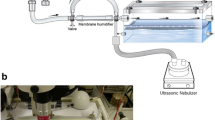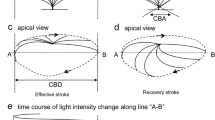Abstract
Mucociliary transport is an important nonimmunological defense mechanism of the respiratory tract. The aim of this study was to investigate the effect of sulfur dioxide (S02) at different concentrations on ciliary beat frequency (CBF). Ciliated cells were obtained from 12 volunteers by nose brush. CBF was quantified using video-interference microscopy. The cells were placed on a polycarbonate membrane in contact with the surface of a reservoir filled with RPMI 1640 (bicarbonate buffered) or Ringer's (electrolyte) solution, allowing the cells to be supplied by capillarity. In an exposure chamber the cells were exposed for 30 min to SO2 2.5–12.5 ppm at 37°C and 100% air humidity. SO2 induced a dose-dependent decrease in CBF of the cells cultured in Ringer's solution. SO2 at 2.5 ppm caused a 42.8 % decrease and at 12.5 ppm a 96.5% decrease (8.1 ± 0.24 versus 0.28 ± 0.20 Hz). CBF of cells cultured in RPMI 1640 was reduced only moderately after 12.5 ppm SO2 exposure (7.9 ± 0.26 versus 6.70 ± 0.30 Hz). In Ringer's solution a decrease in pH was observed after 30 min of S02 exposure to 12.5 ppm to a minimum value of 3.6. By contrast, the pH of RPMI 1640 remained constant at 7.5 under identical conditions. After adding RPMI 1640 to Ringer's solution, CBF increased in parallel to the pH to control values (5.0 ppm: 4.64 ± 0.45 to 8.51 ± 0.60 Hz). These data suggest that the highly water-soluble SO2 reversibly eliminates CBF in correlation with a decrease in pH.
Similar content being viewed by others
Abbreviations
- CBF:
-
ciliary beat frequency
References
Bryan WTK, Bryan MP, Smith CA (1968) Cytochemical factors and some ultrastructural aspects of the epithelium in the secretions from nasal inflammatory diseases. Laryngoscope 78:1020–1040
Buechley RW, Riggan WB, Hasselbad V, Van-Bruggen JB (1973) SO2 levels and pertubations in mortality. A study in the New York-New Jersey metropolis. Arch Environ Health 27:134–137
Buhrmester CC (1933) A study of the hydrogen-ion concentration, nitrogen content, and viscosity of nasal secretions. Ann Otol Rhinol Laryngol 42:778–788
Frank NR, Yoder RE, Brain JD, Yokoyama E (1969) SO2 (31S labeled) absorption by the nose and mouth under conditions of varying concentrations and flow. Arch Environ Health 18:315–332
French JG, Lowrimore G, Nelson WC, Finklea JF, English T, Hertz M (1973) The effect of sulphur dioxide and suspended sulfates on acute respiratory disease. Arch Environ Health 27:129–133
GiesekingR (1968)ElektronenoptischeBefunde zur Bronchialsekretion. Beitr Klin Tuberk 138:332–342
Holma B, Lindegren VI, Andersen JM (1977) pH effects on ciliomotility and morphology of respiratory mucosa. Arch Environ Health 216–226
Iravani J (1968) Das Flimmerepithel. Beitr Klin Tuberk 138:313–324
Jörres R, Magnussen H (1990) Airways response of asthmatics after 30 min exposure at resting ventilation, to 0.25 ppm NO2 or 0.5 ppm SO2. Eur Respir J 3:132–137
Kienast K, Müller-Quernheim J, Knorst M, Schlegel J, Mang C, Ferlinz R (1993) Realitätsnahe in vitro Untersuchung zur Sauerstoffradikalfreisetzung von Alveolarmakrophagen and mononukleären Zellen des peripheren Bluts nach Kurzexpositionen mit SO2. Pneumologie 47:60–65
Negus VE (1934) The action of cilia and the effect of drugs on their activity. Proc R Soc Med 49:571–585
Seltzer J, Scanlon PD, Drazen JM, Ingram RH, Reid L (1984) Morphologic correlation of physiologic changes caused by SO2-induced bronchitis in dogs. Am Rev Respir Dis 129:790–797
Speizer FE, Frank NR (1966) The uptake and release of SO2 by the human nose. Arch Environ Health 12:725–728
Stratmann U, Lehmann RR, Steinbach T, Wessling G (1991) Effect of sulfur dioxide inhalation on the respiratory tract of the rat. Zentralbl Hyg Umweltmed 192:324–335
Tashkin DP, Detels R, Chang P, Simmons M, Coulson A, Sayre J, Rokaw S (1990) Effects of community air pollution and smoking status on annual decline in lung function in three cohorts chronically exposed to different levels of photochemical oxidants, SOx, NOx, and hydrocarbons. Am Rev Respir Dis 141:A69
Ukai K, Bang BG, Bang FB (1984) Effect of infection and SO2 exposure on nasal and paranasal mucociliary clearance in intact chickens. Arch Otorhinolaryngol 239:1–6
Voison C, Aerts C, Jakubczak E, Tonnel AB (1977) La culture cellulaire en phase gazeuse. Un nouveau modele experimental d'etude in vitro activites des macrophages alveolaires. Bull Eur Physiopathol Respir 13:69–82
Wolff RK (1986) Effects of airborne pollutants on mucociliary clearance. Environ Health Perspect 66:223–237
Author information
Authors and Affiliations
Additional information
Correspondence to: K. Kienast
Rights and permissions
About this article
Cite this article
Kienast, K., Riechelmann, H., Knorst, M. et al. An experimental model for the exposure of human ciliated cells to sulfur dioxide at different concentrations. Clin Investig 72, 215–219 (1994). https://doi.org/10.1007/BF00189317
Received:
Accepted:
Issue Date:
DOI: https://doi.org/10.1007/BF00189317




